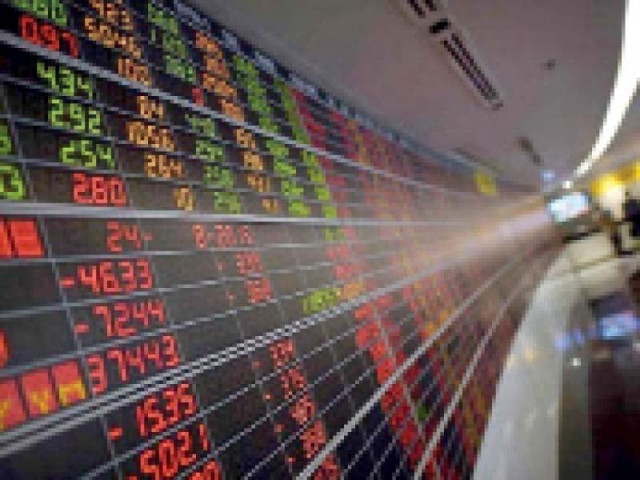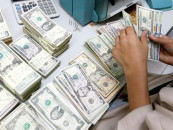Soaring stocks, collapsing economy
Rule: better economy, better market. Why then do we see inverse happening?

Pakistan’s stock market is soaring and it just recently crossed a record high. This would normally be good news were it not for the fact that as the stock market soars the real economy is in freefall. There is near unbearable inflation and unemployment, interest rates are at record highs, the poor are finding it hard to get two meals a day let alone make a living. The country’s natural gas reserves are almost exhausted leading to vital industries being shut down and widespread outages. Power shortages are resulting in hours of load-shedding in most parts of the country effecting common people and businesses alike, private capital is fleeing abroad.
What is going on?
The stock market is normally viewed as a barometer of economic health. The rule is: The better the economy the better the stock market performance. Why then do we see the inverse happening here in Pakistan? Perhaps a review of history and economic theory can shed some light on this conundrum.
The phenomenon where a stock market reaches record highs while the broader economy suffers is not unique to Pakistan. This paradox has historical precedents and can be explained through various economic theories. High inflation, soaring interest rates, and escalating unemployment juxtaposed against a booming stock market is a curious case of economic dissonance. We delve here into how such a scenario can unfold, with historical examples and theoretical frameworks providing a comprehensive understanding.
Several instances in history demonstrate the stark disconnect between stock market performance and economic health. One notable example is the United States during the late 1920s, leading up to the Great Depression. The stock market experienced unprecedented growth, with the Dow Jones Industrial Average reaching peak levels in 1929.
This exuberance, however, masked underlying economic weaknesses such as declining agricultural prices, rising income inequality, and a fragile banking system. When the stock market crashed in October 1929, it not only erased wealth but also exposed and exacerbated the existing economic frailties, leading to the Great Depression.
Another example is the dot-com bubble of the late 1990s. The US stock market, particularly technology stocks, soared on the back of speculative investments in internet-based companies. Despite the apparent prosperity reflected in the stock market indices, many of these companies were not profitable and had unsustainable business models. The eventual burst of the bubble in 2000 led to significant losses in the stock market, while the broader economy faced a recession.
More recently, the period leading up to the 2008 financial crisis saw a similar pattern. Stock markets worldwide, buoyed by high-risk mortgage-backed securities and a credit boom, reached new heights. Meanwhile, the real economy exhibited signs of strain, with increasing household debt and a housing market bubble. The collapse of Lehman Brothers in 2008 triggered a financial crisis that led to a severe global recession. Several economic theories help explain why stock markets can diverge from the broader economic reality:
1. Monetary policy and liquidity: Central banks often respond to economic downturns by lowering interest rates and injecting liquidity into the financial system. While these measures are intended to stimulate the economy, they can also lead to an increase in asset prices, including stocks. The influx of cheap money can create a speculative environment where stock prices rise independently of economic fundamentals.
2. Rational expectations and speculative bubbles: According to the rational expectations theory, investors make decisions based on their expectations of future economic conditions. When investors collectively believe that stock prices will continue to rise, it can create a self-fulfilling prophecy. However, this can also lead to speculative bubbles, where asset prices inflate far beyond their intrinsic value. The eventual correction can be severe, as seen in the historical examples mentioned earlier.
3. Wealth inequality and stock ownership: Wealthier individuals and institutional investors hold a significant proportion of stock market assets. During times of economic hardship, these entities might still have access to capital and investment opportunities that allow them to profit from rising stock prices. Meanwhile, the broader population, facing unemployment and inflation, does not benefit from stock market gains, creating a disconnect between the stock market and the real economy.
4. Corporate Profits versus labour market: Stock prices are often driven by corporate profitability. In times of economic stress, companies may cut costs, including labour, to maintain profit margins. This can lead to rising stock prices even as unemployment increases. Additionally, multinational corporations may benefit from global operations even if the domestic economy is struggling, further decoupling stock market performance from local economic conditions.
In Pakistan, several factors might explain the current disparity between the booming stock market and the collapsing economy:
1. Foreign investment and speculation: Foreign investors, seeking high returns, may invest in Pakistani stocks, driving up prices. These investments can be speculative and do not necessarily reflect the underlying economic conditions. The influx of foreign capital can create a temporary boost in the stock market.
2. Corporate sector resilience: Certain sectors, such as technology, pharmaceuticals, or export-oriented industries, might be performing well despite the broader economic challenges. If these sectors dominate the stock market indices, they can create an illusion of overall market health.
3. Monetary policy: The State Bank of Pakistan’s monetary policies, including high interest rates, can attract foreign portfolio investments seeking higher returns. This can boost the stock market even as domestic borrowing costs rise, negatively impacting local businesses and consumers.
4. Wealth concentration: A small segment of the population, with significant stock holdings, might continue to invest in the market, driving up prices. The majority, facing inflation and unemployment, does not participate in the market gains, exacerbating economic inequality.
The disconnect between stock market performance and the real economy is unsustainable in the long run. Historical examples indicate that such disparities often lead to market corrections. When the speculative bubble bursts or external conditions change (such as a withdrawal of foreign investments), the stock market can experience sharp declines, exacerbating economic challenges.
For Pakistan, the current scenario presents several risks. The reliance on foreign capital and speculative investments can create volatility. High inflation and interest rates, combined with rising unemployment, can lead to social unrest and further economic instability. Policymakers need to address these underlying issues to create a more balanced and sustainable economic environment.
The soaring stock market amid a collapsing economy in Pakistan is a complex phenomenon with historical precedents and theoretical explanations. The examples of the Great Depression, the dot-com bubble, and the 2008 financial crisis illustrate the potential consequences of such a disconnect. Economic theories related to monetary policy, speculative bubbles, wealth inequality, and corporate profitability provide insights into why this disparity occurs. For Pakistan, addressing the underlying economic challenges and ensuring inclusive growth is essential to achieving long-term stability and avoiding the pitfalls of an overheated stock market.
What is particularly disturbing is that the government of Prime Minister Shehbaz Sharif and his acolytes frequently point to Pakistan’s stellar stock market as evidence of the success of their economic policies. If they really believe what they are saying, then we are all in very deep trouble.
THE WRITER IS CHAIRMAN OF MUSTAQBIL PAKISTAN. HE HOLDS AN MBA FROM HARVARD BUSINESS SCHOOL



















COMMENTS
Comments are moderated and generally will be posted if they are on-topic and not abusive.
For more information, please see our Comments FAQ